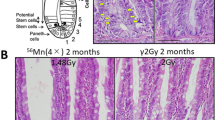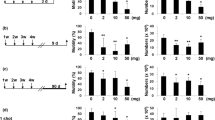Abstract
LOCALIZATION of polonium-210 (210Po) in the interstitial spaces of the testes of rats has been demonstrated radio-autographically1 and a very slow rate of excretion of 210Po from rat testis has also been shown. 210Po is a naturally occurring alpha-emitting element of the uranium decay chain. A particle energy of 5.3 MeV allows a range for the 210Po alpha particle of about 37µ, in tissue. Since this distance is sufficient to penetrate from the interstitial spaces of the testis into the outer cell layers of the seminiferous tubules of the testis where spermatogenesis occurs, it seemed important to ascertain the effect of 210Po on spermatogenesis. The survival of resting primary spermatocytes in stage VII tubules of mouse testis was measured by methods described by Oakberg in studies of the response of the mouse testis to external radiation exposure3 and later used for the evaluation of tritiated thymidine toxicity4. Male Harvard Swiss Wistar mice 2–25 weeks of age were injected peritoneally with 0–2 nc. of 210Po, obtained from the Radiochemical Centre, Amersham, and constituted in 0.05–0.25 ml. of isotonic weakly acid solution prepared by dilution with normal saline. At intervals from 5 days to 10 months after injection, mice were killed by cervical dislocation and their testes removed and fixed in either Bouin's solution or 10 per cent neutral formalin. The tissues were embedded in paraffin and cut into 5µ sections. Prepared slides were stained with periodic acid–Schiff–haematoxylin stains and examined at 1,000 × magnification using an oil immersion objective. Only seminiferous tubules cut in cross-sections so that they appeared round were selected for scoring. Only those tubules in stage VII, as established by maturation of the acrosomes of the spermatids5, were counted. 15–30 tubules were counted from each slide. Serial adjacent sections were avoided. The results are plotted in Fig. 1.
This is a preview of subscription content, access via your institution
Access options
Subscribe to this journal
Receive 51 print issues and online access
$199.00 per year
only $3.90 per issue
Buy this article
- Purchase on Springer Link
- Instant access to full article PDF
Prices may be subject to local taxes which are calculated during checkout
Similar content being viewed by others
References
Silberstein, H. E., et al., in Biological Studies with Polonium, Plutonium and Radium, 73, edit. by Fink, R. M. (McGraw-Hill, New York, 1950).
Stannard, J. N., Radiat. Res. Suppl., 5, 67 (1964).
Oakberg, E. F., Radiat. Res., 2, 369 (1955).
Kisieleski, W. E., Samuels, L. D., and Hiley, P. C., Nature, 202, 458 (1964).
Oakberg, E. F., Amer. J. Anat., 99, 391 (1956).
Monesi, V., J. Cell Biol., 14, 1 (1962).
Oakberg, E. F., and DiMinno, R. L., Intern. J. Rad. Biol., 2, 196 (1960).
Oakberg, E. F., and Clark, E., in Effects of Ionizing Radiation on the Reproductive System, 11, edit. by Carlson, W. D., and Gassner, F. X. (Macmillan, New York, 1964).
Author information
Authors and Affiliations
Rights and permissions
About this article
Cite this article
SAMUELS, L. Depletion of Mouse Spermatogonia following Exposure to Polonium-210. Nature 210, 434–435 (1966). https://doi.org/10.1038/210434a0
Issue Date:
DOI: https://doi.org/10.1038/210434a0
Comments
By submitting a comment you agree to abide by our Terms and Community Guidelines. If you find something abusive or that does not comply with our terms or guidelines please flag it as inappropriate.



